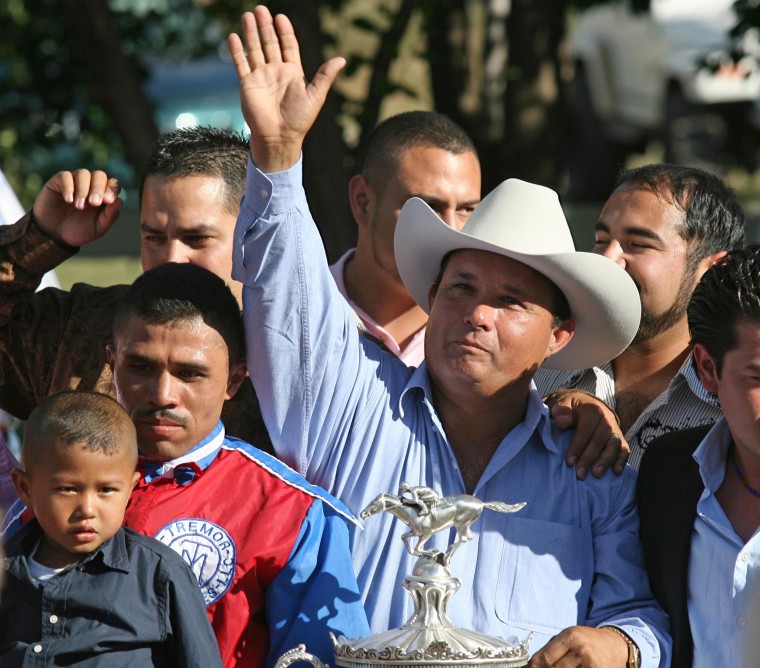In 2011, a particular quarter horse farm in Oklahoma was booming with business – even as the recession was taking a toll on the usually lucrative industry.
The farm's owner, Jose Trevino Morales, had only recently broken into the quarter horse scene and was making waves with his million-dollar prize winnings and record-breaking bids at auction houses. But, according to federal investigators, what seemed like a ranch filled with the top mares was actually a front for a multimillion-dollar money-laundering scheme orchestrated by one of the most dangerous Mexican drug cartels—Los Zetas.
The cartel is one of the most feared in all of Mexico, according to authorities. Its calling card includes dismemberments of rivals while they were still alive and beheadings, authorities say.
According to authorities, the cartel was originally trained by the Mexican military to combat the drug trade, but the cartel eventually turned sides. "They are often bribed to collaborate, but this was the first case of all the originators of a particular cartel leaving the military for the cartel," FBI Special Agent Scott Lawson said.

Trevino Morales was a U.S. citizen with a clean record. He was known throughout the community as a bricklayer, reportedly making only $20,000 a year, who supposedly had come into a large amount of money and was spending it in the quarter horse industry.
Sign up for top Business news delivered direct to your inbox.
But while he may have had a clean slate in the U.S., his infamous brothers were on the run in Mexico, investigators say. His older brothers —Miguel Angel Trevino Morales and Omar Trevino Morales, known as "40" and "42" respectively — were leaders of Los Zetas.
Nineteen people have been indicted in a money laundering case, with one acquitted due to cooperation. Ten of the 19 have been convicted, and some of them recently were sentenced. This is the first time authorities have been able to speak about the case.
Trevino Morales was sentenced in September 2013, and is serving a 20-year sentence. His attorney could not be reached for comment. His two older brothers remain incarcerated in Mexico but are still wanted by U.S. authorities.
"They really thought that the quarter horse racing industry was a great place to run this scheme and stay under the radar from U.S. law enforcement."
It all began at a quarter horse auction in Oklahoma City.
Lawson, who immersed himself in the case for years, said agents got their first tip from an informant in January 2010. It was at one of the biggest auctions in the quarter horse industry in Oklahoma.
A horse named "Dashin Follies" had recently sold for a record $875,000. But more important to investigators was the buyer: Miguel Trevino Morales, one of the two eldest brothers.
The cartel's scheme was simple. Drugs would travel north from Mexico, and illicit profits earned would travel south.
And the way to hide the cartel's millions was to create shell companies in a lucrative American sector—the quarter horse industry. By outside appearances, they were running a legitimate business that bought, bred and raced American quarter horses, but in reality it was just a means to hide their illicit profits.
"They really thought that the quarter horse racing industry was a great place to run this scheme and stay under the radar from U.S. law enforcement," Lawson said. Their main shell company, named "Tremor Enterprises," and was responsible for funneling at least $16 million over the course of three years and owned by the youngest brother.
According to investigators, the Los Zetas cartel wasn't just winning races with the millions spent on mares, they were also fixing the races. "They were actually extorting gate openers," Lawson said.
But Lawson added it was the Los Zetas' pride that helped investigators seal the case.
In some instances, the youngest brother changed the names of the horses, an unusual practice in the industry. He chose names such as "Number One Cartel," "My Brother's Secret" and "Forty Force." Additionally, images of Trevino Morales and other members of the cartel posing in winners circles—flashing cartel signs—led authorities to the source.
The presumed brick layer, meanwhile, was living large. In 2011, he purchased a 140-acre farm in Oklahoma, and moved his entire family to their new home, along with 522 quarter horses. But Lawson said by this time, the FBI had already been tracking Trevino Morales' moves for years. Investigators had more than enough evidence to take down not only Morales, but his two brothers.
On June 12, 2012, following years of surveillance using embedded agents and informants, more than 300 agents in the Oklahoma City area seized the massive farm, purchased only months before. Authorities arrested Trevino Morales, and seized about $28 million in assets, including two private jets, cash, the ranch and $12 million worth of champion quarter horses.
There are currently seven fugitives at large related to the case.